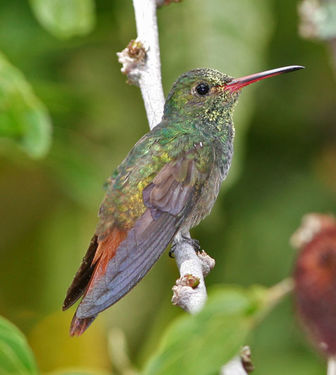Rufous-tailed Hummingbird
This is a common to abundant bird of open country, river banks, woodland, scrub, forest edge, coffee plantations and gardens up to 1850 m .

Original source: Own work
Author: http://www.birdphotos.comPermission(Reusing this file)See below. Attribution must appear on the same page as the photo.
The Rufous-tailed Hummingbird is classified as Least Concern. Does not qualify for a more at risk category. Widespread and abundant taxa are included in this category.
The Rufous-tailed Hummingbird (Amazilia tzacatl) is a medium-sized hummingbird which breeds from east-central Mexico, through Central America and Colombia, east to western Venezuela and south through western Ecuador to near the border with Peru. The larger Escudo Hummingbird from Isla Escudo de Veraguas in Panama is commonly considered a subspecies of the Rufous-tailed Hummingbird. This is a common to abundant bird of open country, river banks, woodland, scrub, forest edge, coffee plantations and gardens up to 1850 m (6000 ft). More
Rufous-tailed Hummingbirds are mostly iridescent green in color but get their common name from their contrasting rufous tails. These medium-sized hummingbirds have red bills and green gorgets. The sexes are similar, but the males have more green iridescence and the upper mandible of a female's bill is completely black, while that of a male shows some red. More
The Rufous-tailed Hummingbird (Amazilia tzacatl) is a medium-sized hummingbird which breeds from northeast Mexico south to western Venezuela and western Ecuador. This is a common to abundant bird of open country, river banks, coffee plantations and gardens up to 1850 m, and also occurs in scrub at woodland edges and clearings. The adult Rufous-tailed Hummingbird is 10cm long and weighs 5.2 g. It has has mostly shiny green body plumage, apart from a greyish belly and rufous tail. More
The adult Rufous-tailed Hummingbird is 10-12 cm (4-4,8 in) long and weighs approx. 5.2 g (0,2 oz). The throat is green (edged whitish in the female), the crown, back and flanks are green tinged golden, the belly is pale greyish, the vent and rump are rufous and the slightly forked tail is rufous with a dusky tip. The almost straight bill is red with a black tip; broadest on the upper mandible, which may appear all black. Immatures are virtually identical to the female. More
Rufous-tailed Hummingbird (Amazilia Tzacatl) Photo taken in Ecuador by hummingbird.org * Rufous-tailed Hummingbird Photo by Worldbirder.com * Rufous-tailed Hummer by cayaya-birding.com cover Opus 26004 Garden Ballet Hummingbird Feeder Mobile The Hummingbird Blog Hummingbird Stuff Copyright 2004 Finchworld Inc. More
Rufous-tailed Hummingbird, Latin America. Find similar images Availability: Availability for this image cannot be guaranteed until time of purchase. Show keywords and more details Rights-managed pricing Learn about rights-managed licensing Prices in USD Calculate price Rights-managed pricing is based on how you plan to use this image. Select keywords to find similar images Tip: Select fewer keywords to get more results. More
Rufous-tailed Hummingbird videos on the Internet Bird Collection Rufous-tailed Hummingbird photos-3+Gallery; Article w/RangeMaps InfoNatura NatureServe Photo-Medium Res; Article chandra.as.utexas.edu–"Birds of Ecuador" Rufous-tailed Hummingbird photo gallery VIREO Didn't find what you were looking for. Need more information for your travel research or homework? Ask your questions at the forum about Birds of Colombia or help others to find answers. This article is licensed under the GNU Free Documentation License. More
Rufous-tailed Hummingbird by Gualberto107 on flickr.com Most common hummer in Panama, Nikon D300 and the Nikon AF 70-300mm lens. Tags: Nature, Environment, Endangered Species, tree, forest, bird, birding, Green, Farming, World, tropical, tropics, Climate Change, little, Rainforest, colors, brown, feathers, branch, wings, PANAMA, HUMMER, hummingbird, beak, birdwatching, tailed, perched, rufous Photo PropertiesNP! ID: 2037349Title: Rufous-tailed HummingbirdFile Size: 500 × 343 – 58. More
The rufous-tailed hummingbird (Amazilia tzacatl) is a medium-sized perky, active and aggressive species that occurs in a variety of habitats. It prefers open scrubby areas, gardens and plantations. It regularly visits nectar-feeders. It forages for nectar on many types of flowering plants; Hamelia, Heliconia and Cephaelis. Males vigorously defend foraging sites. Studies by University of Missouri researchers show that aggression by males tapers off if intruders vastly outsize the combative individual. Smaller intruders are vigorously attacked. More
Rufous-tailed hummingbird doing some stretching on a tree branch showing his tail feathers Other images from Gualberto Becerra 's portfolio | View All * Stock photo: * Stock photo: * Stock photo: * Stock photo: More
The female Rufous-tailed Hummingbird is entirely responsible for nest building and incubation. She lays two white eggs in a compact cup nest constructed from plant-fibre and dead leaves 1-6 m high on a thin horizontal twig. Incubation takes 15-19 days, and fledging another 20-26. The food of this species is nectar, taken from a variety of flowers, including Heliconias and bananas. Like other hummingbirds it also takes small insects as an essential source of protein. More
Rufous-tailed hummingbird nest in Costa Rica = Coredumpcr 37 vidéos S'abonnerModifier l'abonnement Chargement… 4914 vues 4914 vues Coredumpcr — 9 septembre 2006 — A pair of chicks from a hummingbird being fed by their mother. Taken in San José, Costa Rica. www.wikicostarica... Coredumpcr — 9 septembre 2006 — A pair of chicks from a hummingbird being fed by their mother. Taken in San José, Costa Rica. www.wikicostarica. More
Rufous-tailed Hummingbird at Firecracker plant (Panama) = HummingbirdSociety 3 vidéos FollowModifier l'abonnement Chargement… 246 vues 246 vues HummingbirdSociety — 17 mars 2009 — This blossom-laden Firecracker plant (Russelia equisetifomis) supplied plenty of nectar to a visiting Rufous-tai... HummingbirdSociety — 17 mars 2009 — This blossom-laden Firecracker plant (Russelia equisetifomis) supplied plenty of nectar to a visiting Rufous-tailed Hummingbird (Amazilia tzacatl). Used with permission of the videographer, Ralph Dessau. More

Original source: Dcljr
Author: Dcljr
Permission: Some rights reserved
Family : Trochilidae
Genus : Amazilia
Species : tzacatl
Authority : (de la Llave, 1833)

